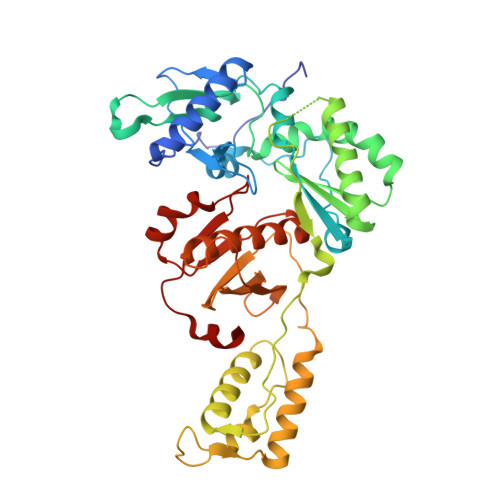Structural basis for potent and broad inhibition of HIV-1 RT by thiophene[3,2-d]pyrimidine non-nucleoside inhibitors.
Yang, Y., Kang, D., Nguyen, L.A., Smithline, Z.B., Pannecouque, C., Zhan, P., Liu, X., Steitz, T.A.(2018) Elife 7
- PubMed: 30044217
- DOI: https://doi.org/10.7554/eLife.36340
- Primary Citation of Related Structures:
6C0J, 6C0K, 6C0L, 6C0N, 6C0O, 6C0P, 6C0R, 6CGF, 6DUF, 6DUG, 6DUH - PubMed Abstract:
Rapid generation of drug-resistant mutations in HIV-1 reverse transcriptase (RT), a prime target for anti-HIV therapy, poses a major impediment to effective anti-HIV treatment. Our previous efforts have led to the development of two novel non-nucleoside reverse transcriptase inhibitors (NNRTIs) with piperidine-substituted thiophene[3,2- d ]pyrimidine scaffolds, compounds K-5a2 and 25a, which demonstrate highly potent anti-HIV-1 activities and improved resistance profiles compared with etravirine and rilpivirine, respectively. Here, we have determined the crystal structures of HIV-1 wild-type (WT) RT and seven RT variants bearing prevalent drug-resistant mutations in complex with K-5a2 or 25a at ~2 Å resolution. These high-resolution structures illustrate the molecular details of the extensive hydrophobic interactions and the network of main chain hydrogen bonds formed between the NNRTIs and the RT inhibitor-binding pocket, and provide valuable insights into the favorable structural features that can be employed for designing NNRTIs that are broadly active against drug-resistant HIV-1 variants.
Organizational Affiliation:
Department of Molecular Biophysics and Biochemistry, Yale University, New Haven, United States.






















